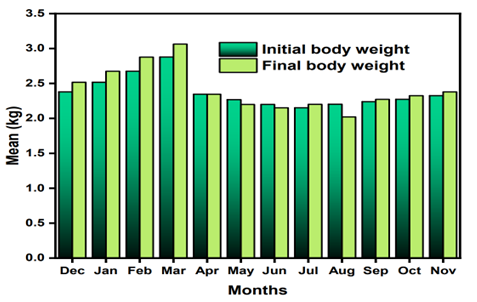IMPACT OF VARIOUS TEMPERATURES ON THE HEMATOLOGICAL AND BIOCHEMICAL INDICES, PREGNANCY, GROWTH AND SURVIVAL RATE OF ANGORA RABBIT IN CAPTIVITY
DOI:
https://doi.org/10.71146/kjmr362Keywords:
Angora rabbit, biological parameters, pregnancy, temperature, MardanAbstract
The Angora rabbit, named scientifically as Oryctolagus cuniculus, is one of the most well-known candidates for its cashmere-like fleece which is very rich wooly fiber used in the making of woolen fabrics. The indicator of hematological and biochemical aspects is extremely valuable in determining the health and well-being of animals. A one-year experiment was carried out in the Mardan area with 20 adult female angora rabbits to evaluate how same life conditions affect pregnancy outcomes, growth rate, hematological and biochemical parameters including cholesterol level. The temperatures of the forecast region were tracked down daily throughout all seasons, winter (December-February), spring (March-May), summer (June-August) and fall (September-November). The biomedical data, specifically, the body weight, pregnancy, the hematological and biochemical indices were recorded. The ambient temperature in winter, spring, summer, and autumn was 18.3ºc, 30.15ºc, 35.85ºc, and 29.2ºc. Several blood parameters from pregnant and non-pregnant rabbits were studied. Pregnant rabbits showed significantly lower RBC and WBC counts, lymphocyte ratios, and hemoglobin concentrations than non-pregnant rabbits (p<0.05). The biochemical features of pregnant and non-pregnant rabbits were examined. Pregnant rabbits showed significantly lower amounts of total protein, albumin triglyceride, cholesterol, calcium, and phosphorus than non-pregnant rabbits (p < 0.05). In summer, female rabbits had lower (p<0.05) erythrocyte count, hemoglobin concentration, mean corpuscular hemoglobin, and mean corpuscular hemoglobin concentration. Summer was the season with the highest albumin level values. Winter had a greater mean total protein level than spring, summer, and fall. The rabbit puts on weight in the winter, which is the finest season, and there is no such difference found in the summer. Winter has high pregnancy rates, indicating that it is the best season for breeding. All analysis was done through SPSS tools such as one-way ANOVA and paired t-test.
Downloads

Downloads
Published
Issue
Section
License
Copyright (c) 2025 Amna Gul, Zia ul Islam, Muhammad Qayash Khan , Saman Yaqub, Brekhna Faheem, Gule Tanzila, Amal Rahim, Zubair Ali (Author)

This work is licensed under a Creative Commons Attribution 4.0 International License.






